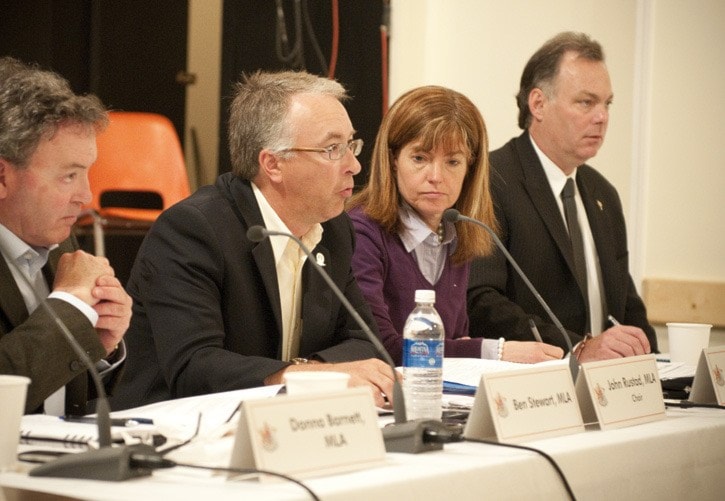It became clear from the presentations to the Special Committee on Timber Supply on June 20, the committee has a tough job ahead.
The committee heard from community leaders, industry and forest professionals in a packed Music Makers Hall last week.
The committee is travelling around the province getting input on options put forward to help mitigate the impacts of the upcoming decline in the supply of wood fiber available to the interior of British Columbia’s forest industry.
The committee was struck to attempt to address the upcoming decline in timber supply in the province after the Pine Beetle epidemic. They will be asking for input on options to mitigate the loss of about 10 million cubic metres of wood a year, which is about 20 per cent of the interior’s wood supply. This represents the wood needed to supply approximately eight sawmills and the reduction in supply is expected to take place within two to 10 years.
The decline is a result of the rapid increase in the annual allowable cut to harvest the dead standing pine which had been damaged by the beetle infestation but if left would be unsalvageable for any economic benefits.
Seven MLAs from both the Liberals and the NDP make up the committee and the group is traveling around the province to conduct a series of formal meetings where local governments, First Nations, industry and public can present.
The committee was asking for input on a number of recommendations which could increase the timber supply and if they were to be implemented, which areas require changes to legislation.
The recommendations included allowing harvest in some protected areas including reducing some of the Visual Quality Objectives, which prevented logging of the views around towns, parks or along highways to protect tourism and other aesthetic values.
Mayor Rob MacDougall said a few words before turning over the presentation to Ross Hamilton of KDL, the company managingthe community forest for the community.
Hamilton gave a very thorough response to the points being looked at by the committee as potential sources of increased timber supply.
Overall, Hamilton said the opportunity to increase timber supply by changes to allow harvesting in protected areas are limited and could impact certifications of wood products which may then impact the producers ability to sell their end products.
He also expressed concern over the actual inventory numbers of available wood, which he suggested should be assessed in order to properly plan the harvest of the mid-term timber.
Many of the presenters mentioned keeping the resource within the area, to ensure the local community is sustainable, with the notable exception of both the Sinclar Group and Dunkley Lumber, which would like to be able to ensure their ability to continue to move logs to their mills in other communities.
“You are hearing that timber should stay locally,” said Blair Mayse, business development advisor for Dunkley. “ If you adopt that recommendation, you in essence eliminate Dunkley’s ability to access timber supply.
There are others that need supplemental timber, all of which comes from this great big area.”
Dunkley Lumber owns the timber licence which was owned by Stuart Lake Lumber. Owners of Stuart Lake Lumber sold the closed mill and its licence to Dunkley, which operates a large mill north of Quesnel, in November of 2009.
There were presentations as well by Nak’azdli, Tl’azt’en, and Takla First Nations, but Yekooche did not participate.
All three groups did not support significant changes to allow harvesting in protected areas or any practices which could jeopardize other uses of forests by wildlife and cultural practices.
There were also strong calls for more economic benefit of the resource extraction to go towards the First Nation communities.
“I think I really would like this committee to really think hard of the First Nations’ interests, that we still reside and live off this land, and we have never surrendered our land to anyone,” said Chief Dolly Abraham of Takla First Nation.
Retired forester Keith Gordon also spoke from a forest professional’s perspective on the possible options for mitigating the drop in timber supply.
“In short, the ways offered to government are to log land where careful planning, the LRMPs and all the negotiations that were carried out, decreed that we should not log these portions,” said Gordon. “And now we’re saying that we should go back and do it, so we can have more timber.
I just ask you to remember how carefully those were negotiated because they meant a hell of a lot.”
Most of those presenting did not necessarily want to see an abandonment of current restrictions protecting certain areas, but perhaps the clearest message came from a non-forestry speaker.
After explaining some of his concerns over the recommendations being examined, Tom Greenaway, director of Electoral area C for the Regional District of Bulkley-Nechako said “May our grandchildren be proud of our footprint that we leave today.”
The special committee will be continuing to tour interior communities until July 12 and will be putting forward a report by August 15 in order to give the provincial government direction in dealing with the issue.
